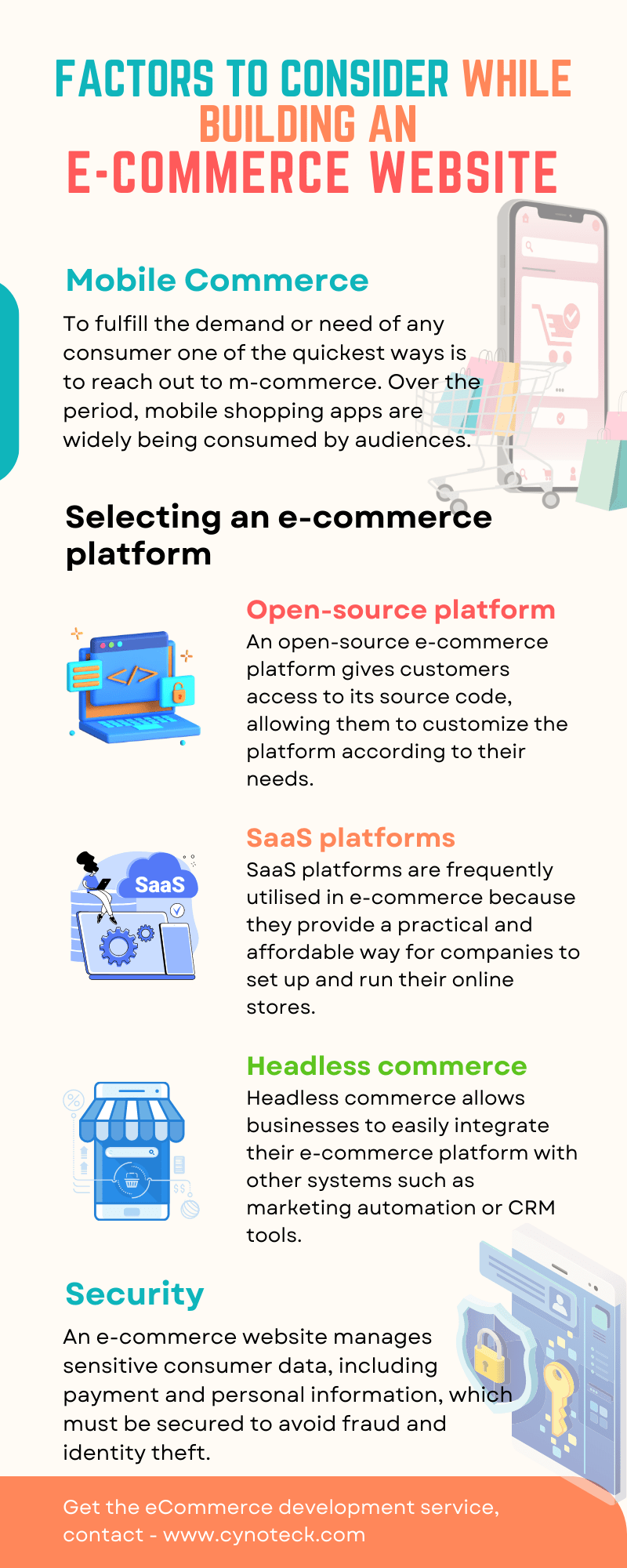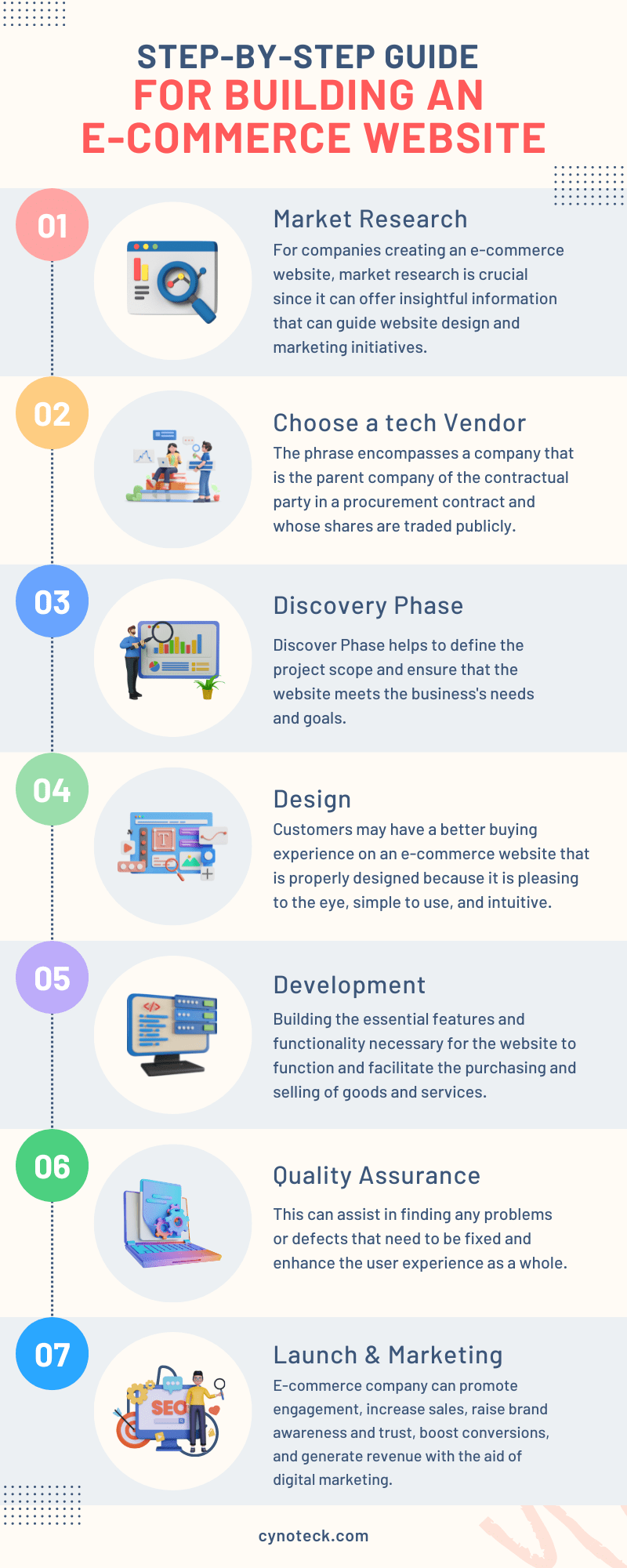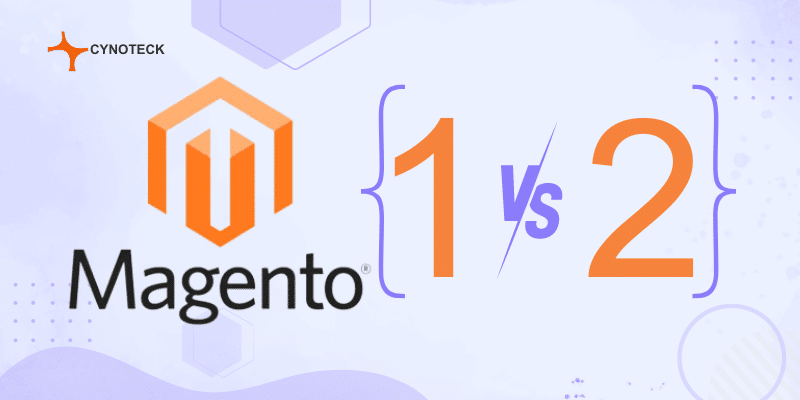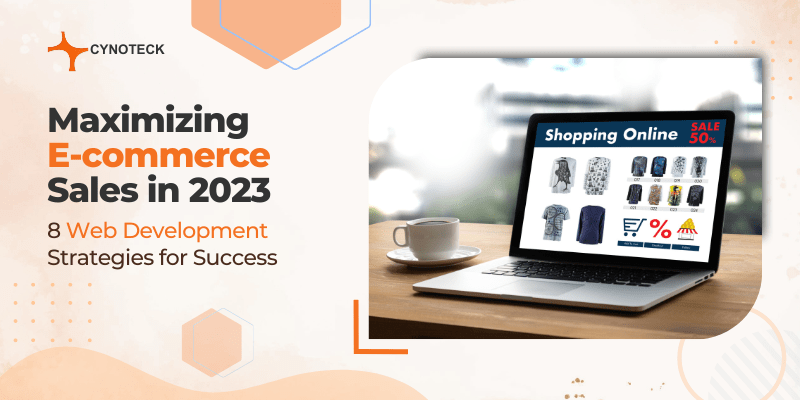Building an e-commerce website is a necessity for the survival of the business. To persuade, enhance, and reach out to customers – an e-commerce platform is tremendously helpful. It’s the best way to increase sales with existing users. Through in-depth research, we’ve assembled a step-by-step guide on the formation of building an e-commerce website.
Overview
E-commerce sales are expected to continue to grow in the coming years. According to eMarketer, global e-commerce sales are expected to reach $4.9 trillion in 2022 and $6.5 trillion in 2024.
E-commerce has a great impact on brick-and-mortar retailers as more people choose to shop online instead of in physical stores. Many retailers have responded by developing their own online stores or partnering with e-commerce platforms such as Amazon or Squarespace.
Over the years, the web space has allotted business opportunities to not only the existing offline market but also to new online-only ventures. Businesses that work exclusively through single platforms or through e-commerce platforms. These businesses contain products that are not available in the stores and attract users to visit the online stores.
Also, read: Salesforce eCommerce pricing: know what to expect
The future of E-commerce
In 2021, social media platforms such as Facebook, Instagram, and Pinterest accounted for over a third of all e-commerce traffic worldwide.
In the digitalized era, technology will keep advancing to grow in the e-commerce sector. Through various ways, businesses will try to capture the need of the masses.
Over the period people are transforming their lifestyles as per the comforts offered by online services and solutions.
Consumers as well as e-commerce websites, both will keep on growing. With the adamant of artificial intelligence and machine learning the consumer base will keep on increasing. The reason is a better customer experience’.
There are many factors that will weigh its scale on the E-commerce platform’s side. Product or service price, overall customer experience, the comfort of online availability, and much more. With time with new and better updates, the whole process will become much more attractive to users.
According to a survey by Epsilon, 85% of consumers are more likely to purchase from a company if it offers personalized experiences.
There’d be a huge expansion of the e-commerce market in the upcoming years. During the pandemic, social media platforms received tremendous traffic and led entrepreneur’s ventures to attract new customers. Both national as well as international audiences can be targeted through these platforms easily.
Are you looking to take your eCommerce Business to the next level?
Get Ahead of the Ecommerce Game: Professional Development Services to Boost Your Online Sales
How effective can building e-commerce be for business?
A company can reach a larger audience by developing an e-commerce website because clients can make purchases there from any location with an internet connection. It provides convenience for the company’s clients as well.
The company has remote order management and payment processing capabilities. E-commerce websites can enhance sales since they give clients another way to make purchases. Since it doesn’t take as much investment as creating a physical shop, it is regarded as a cost-effective option for a business to attract new clients.
A survey by Adobe found that 52% of consumers said they would be more likely to purchase from a company that has a strong commitment to sustainability.
Compared to conventional stores, e-commerce websites are significantly less expensive to maintain and update. Due to the ease and speed with which updates may be made without changing the physical storefront.
Because it enables a firm to exhibit its goods and services to a larger audience, the online market aids in raising brand awareness.
The popularity of e-commerce platforms has greatly increased. Given that more and more customers are making their purchases online, an e-commerce website can help a company remain competitive in today’s market.
By giving customers access to information and resources like product descriptions and customer reviews as well as making it simple for them to track orders and returns, businesses may enhance the overall customer experience.
Also, read: Top Web App Development Mistakes to avoid in 2022
Important factors to consider while building an e-commerce website

Mobile Commerce
M-commerce, or mobile commerce, is the term used to describe the buying and selling of products and services via mobile devices like smartphones and tablets. Since more and more individuals are shopping online using their mobile devices, m-commerce has grown in significance.
Mobile commerce is expected to continue to play a significant role in the e-commerce industry. In 2021, mobile devices accounted for over half of all e-commerce traffic worldwide.
People are increasingly spending most of their time on cell phones. Reaching out to your mobile device is most feasible. Consumers are preferring to shop directly from mobile phones and opt for e-commerce at regular intervals.
To fulfill the demand or need of any consumer one of the quickest ways is to reach out to m-commerce. Over the period, mobile shopping apps are widely being consumed by audiences. Not only do these sites help customers to easily fetch want is required, but from a business perspective, it increases sales.
A mobile-friendly e-commerce website can enable a business to increase its search engine visibility because Google and other search engines give preference to mobile-friendly websites in their search rankings.
Businesses can also get vital client information from a mobile-friendly e-commerce website, such as statistics and billing information, which can be utilized to target marketing campaigns and enhance the overall user experience.
Also, read: Magento PWA Studio – Developing PWAs for your Magento eCommerce Store
Selecting an e-commerce platform
a) Open-source platform
An open-source e-commerce platform gives customers access to its source code, allowing them to customize the platform according to their needs and control the look and feel of their online store.
For example, Open-source e-commerce platforms include Magento, WooCommerce, and OpenCart.
The fact that open-source systems typically cost less to use than proprietary platforms since companies don’t have to pay licensing costs is one of its main advantages. Additionally, these platforms frequently have a sizable and vibrant user and developer community, which can offer helpful assistance and resources.
It is important to note that technical expertise is required at an advanced level to set up an open-source platform. In this manner, it gets totally dependent on businesses to host and manage the complete software by themselves.
b) SaaS platforms
A method of distributing applications over the Internet as a service is known as software as a service (or SaaS). You can avoid complicated software and hardware maintenance by just accessing software over the Internet rather than installing and maintaining it.
SaaS applications are also referred to as hosted software, web-based software, and on-demand software. Whatever name they go by, SaaS applications run on the servers of a SaaS provider. Security, availability, and performance of access to the application are all managed by the supplier.
SaaS platforms are frequently utilised in e-commerce because they provide a practical and affordable way for companies to set up and run their online stores.
Shopify, BigCommerce, and Volusion are a few instances of SaaS e-commerce platforms. SaaS systems don’t require organisations to instal or maintain any software, making them exceedingly simple to set up and operate.
They frequently provide a variety of features and tools, including marketing and analytics tools, to assist businesses in managing and expanding their online storefronts.
Although it is important to note that a SaaS platform is comparatively costlier than self-hosted or open-source platforms. Why? The reason is that a subscription fee’ is required to use the software.
c) Headless commerce
A particular kind of e-commerce platform called headless commerce separates the front-end user interface (UI) from the back-end operations like inventory control and order processing.
In a headless commerce system, the front-end user interface (UX) can be created with any technology, such as a website or mobile app, and the e-commerce platform manages the back-end operations.
Since headless commerce necessitates the integration of numerous systems and technologies, it might be more difficult to set up and manage than typical e-commerce platforms.
Additionally, headless commerce could not provide as many features and functionalities right out of the box as conventional e-commerce platforms.
Businesses can create a seamless shopping experience for customers. This can design the front-end UI to match their brand and meet the specific needs of their customers.
Headless commerce also allows businesses to easily integrate their e-commerce platform with other systems such as marketing automation or CRM tools.
Security
Any e-commerce website must maintain security in order to safeguard both the company and its clients from online dangers like hacking and data leaks.
An e-commerce website manages sensitive consumer data, including payment and personal information, which must be secured to avoid fraud and identity theft.
A security breach or data leak can seriously affect a company’s bottom line by harming its reputation and causing a loss of customer trust.
E-commerce security is an important set of protocols that enable secure e-commerce transactions and shield customers’ and businesses’ data from dangers such as spoofing scams, hacking, credit card fraud, data entry mistakes, and unsecured internet services.
E-commerce websites should put in place a variety of security measures, like secure sockets layer (SSL) encryption, firewalls, and secure payment gateways, to preserve security.
Additionally, companies should upgrade their security protocols frequently to stay abreast of the most recent threats and vulnerabilities.
Also, read: What can web-based applications do? – the expert approach
Features of E-commerce website
Let us discuss some important features of an E-commerce website:
- Product listings: A typical e-commerce website features a list of the goods and services it offers for sale, along with thorough descriptions and photos.
- Shopping Cart: You can add utilities to your cart and prepare it for order. Features like keeping a track record and purchase details availability are a few perks.
- Payment processing: A secure payment gateway is often present on an e-commerce website in order to accept orders and manage financial transactions.
- Customer account management: Customers may register with your e-commerce site to track orders, save payment and shipping details, and access additional features such as wish lists and product recommendations.
- Mobile-friendly design: With more and more consumers using smartphones and tablets to shop online, e-commerce websites need to be mobile-friendly.
- Search and navigation: An e-commerce website should include a search feature and clear navigation to help customers find the products they are looking for.
- Customer reviews and ratings: Customer reviews and ratings can help to build trust and credibility for an e-commerce website, as they provide valuable insights into the quality and performance of products.
- Product recommendations: Product recommendations can help to increase sales by suggesting related or complementary products to customers based on their browsing and purchase history.
- Marketing and promotional tools: An e-commerce website may include marketing and promotional tools, such as email marketing and discount codes, to help businesses reach and retain customers.
- MVP for a website owner: An admin panel, also known as a back-end or control panel, is a web-based interface that allows website administrators to manage and maintain the website. In an e-commerce website, the admin panel is typically used to manage the following tasks:
- Adding and updating products: The admin panel allows website administrators to add and update products, including descriptions, images, and pricing.
- Processing orders: It is a central location to view and manage orders, including tracking orders, processing payments, and updating shipping information.
- Managing customer accounts: The admin panel may include features for managing customer accounts, such as the ability to view and update customer details, track customer activity, and manage customer orders.
- Managing website content: This includes allowing website administrators to add and update website content, such as pages, blog posts, and images.
- Analyzing website performance: Analytical tools to help website administrators track and analyze website traffic and performance, such as page views, conversion rates, and revenue.
Also, read: The Ultimate Website Maintenance Checklist for Businesses
Step-by-step guide for building an E-commerce website

Step 1: Market Research
The process of acquiring and examining information on a target market’s size, demographics, and needs is known as market research. For companies creating an e-commerce website, market research is crucial since it can offer insightful information that can guide website design and marketing initiatives.
It includes details like age, gender, and region to help firms identify their target market. The target audience’s needs can be more effectively met by the website design and marketing initiatives when this information is taken into account.
Consumer demands and preferences, such as the kinds of goods or services they are interested in, their price sensitivity, and their preferred purchasing channels, can be better understood by market research.
Businesses can also use this information to recognize their rivals and comprehend their advantages and disadvantages. The outcome of such a function aid in differentiating and positioning the e-commerce website in the market. A company can better comprehend the market’s size and growth potential with the use of market research.
Step 2: Choose a tech Vendor
The term “tech vendor” refers to a person or entity that provides or proposes to provide information technology goods or services. This term excludes employees of the office, state agencies, and state instrumentalities.
The phrase encompasses a company that is the parent company of the contractual party in a procurement contract and whose shares are traded publicly.
Tech suppliers frequently possess a plethora of knowledge and experience in their industry, which can be helpful for companies developing e-commerce websites.
They can offer advice on best practices and assist in locating and resolving any potential technical issues. Working with a tech vendor can save firms money since it eliminates the need to create and maintain an internal staff and gives them access to resources and specialized knowledge.
Also, read: Top 9 Software Development Models to Choose From: Phases and Applications
Step 3: Discovery Phase
The discovery phase is an important part of the process of building an e-commerce website, as it helps to define the project scope and ensure that the website meets the business’s needs and goals.
Now let us discuss some of the benefits of conducting a discovery phase when building an e-commerce website including:
- Defining project scope: The discovery phase allows a business to clearly define the scope of the project, including the goals and objectives of the e-commerce website and the target audience. It ensures that the project stays focused and on track.
- Identifying requirements: It helps businesses to identify and document the specific requirements for the e-commerce website, including features, functionality, and technical requirements. This helps to ensure that the website meets the needs of the business and its customers.
- Identifying potential challenges: The discovery phase also allows a business to identify potential challenges and risks that may arise during the project, and to plan and prepare for them.
- Establishing a timeline and budget: Establishing a timeline is important and so is the planned budget for the project. The discovery helps to ensure that the website is built and launched on schedule and within budget.
- Improving communication: To improve communication between the business & the development team, the discovery phase provides an opportunity for both parties to discuss and clarify project details and expectations.
Step 4: Design
When creating an e-commerce website, design is crucial since it has an impact on user experience and overall effectiveness.
Customers may have a better buying experience on an e-commerce website that is properly designed because it is pleasing to the eye, simple to use, and intuitive.
It can help to enhance conversions by making it simpler for customers to identify and buy things and by enhancing the company’s credibility and trust.
As it may effectively convey the company’s values and personality, the design of an e-commerce website can contribute to improving the branding and image of the company.
Additionally, it raises a website’s overall search engine ranks since Google and other search engines give preference to user-friendly and mobile-friendly websites. It helps to create a satisfying and memorable shopping experience that motivates people to come back.
Step 5: Development
The process of developing an e-commerce website is crucial since it entails building the technological framework and functionality required for the website to function properly.
Building the essential features and functionality necessary for the website to function and facilitate the purchasing and selling of goods and services results in a fully operating e-commerce website.
It also guarantees the safety of an e-commerce website by putting in place safeguards like secure sockets layer (SSL) encryption and secure payment gateways to safeguard user information and thwart fraud.
In essence, the development of an e-commerce website improves the user experience overall. Businesses can develop features and functions that make it easier for customers to find and buy products.
The scalability of an e-commerce website is increased by the ability of a company to construct and manage a website that can change and grow as the business expands.
Step 6: Quality Assurance
An e-commerce website’s release process is crucial since it entails putting the site online and accessible to users. It enables the company to launch formally and start offering its goods or services for sale.
Additionally, it enables the firm to obtain user feedback and test the website in a real-world setting. This can assist in finding any problems or defects that need to be fixed and enhance the user experience as a whole.
By enabling the company to generate income and start marketing its goods or services to a larger audience, the launch of the e-commerce website can help the company gain traction.
Quality assurance also helps a company establish its market position and build a customer base. Businesses can track and measure the success & performance of their website, including metrics such as traffic, conversions, and revenue. This information may be used to inform future development and marketing activities.
Step 7: Launch & Marketing
Everyone who is associated with your business will benefit from the launch of a successful e-commerce brand. It introduces a product range that draws in new clients and keeps old ones coming back.
The customer journey is extended, and more possibilities to contribute value are presented. Marketing for e-commerce companies readily outperforms traditional marketing, as can be shown from the results.
An e-commerce company can promote engagement, increase sales, raise brand awareness and trust, boost conversions, and generate revenue with the aid of digital marketing.
This allows an e-commerce site to attract customers and bring money to the business. In addition, it contributes to the company’s brand awareness and market presence.
Launching and marketing an e-commerce website helps us collect user input that can be used to improve the website and its services.
The entire launch process allows the company to monitor and evaluate website performance, including metrics such as traffic, conversions, and revenue. Future marketing and development initiatives can benefit from this information.
Also, read: Top Web Development Challenges and Solutions
Price of building an e-commerce website 2023
It is challenging to predict the cost of developing an e-commerce website in 2023 because the price can vary widely depending on a variety of variables, including the size and complexity of the website, the features, and functionality needed, and the resources and development team involved.
You can check a detailed estimation of the total cost of building an e-commerce website here- How much does an E-Commerce website cost in 2023?
How can Cynoteck assist you?
Cynoteck helps in e-commerce website development solutions. We assist in the delivery of flexible, scalable, and powerful e-business solutions that are efficient and effective and can boost conversion rates.
Any e-commerce solution must go through a number of steps before it can be launched, from the product supply procedure to the development process.
In order to give you the most suitable E-commerce solution for your business, we at Cynoteck study and comprehend all of your needs.
We offer a wide array of web application development services to augment, develop, manage, and better maintain your web material at a reasonable cost.
We offer a complete suite of services including custom websites, web applications, e-commerce online solutions, mobile phone integrations, and much more to fulfill the needs of small, mid-sized, and large businesses.
Our core area of work has been into building scalable web portals conforming to Web 2.0 standards – sites that can withstand millions of hits every day while surviving scalability and security pressures.
Are you looking to take your eCommerce Business to the next level?
Get Ahead of the Ecommerce Game: Professional Development Services to Boost Your Online Sales
Conclusion
We assist in the delivery of flexible, scalable, and powerful e-business solutions that are efficient and effective and can boost conversion rates. Any e-commerce solution must go through a number of steps before it can be launched, from the product supply procedure to the development process. In order to give you the most suitable E-commerce solution for your business, we at Cynoteck study and comprehend all of your needs.
The cost of building an e-commerce website can vary significantly based on a range of factors such as customization, third-party integrations, the design, and development team, and hosting and maintenance expenses. It is important for businesses to carefully consider these factors and work with a development team to determine a budget and plan that meets their needs and goals.
Also, read: 5 Things most successful business Apps have in common
Frequently Asked Questions:
The size and complexity of the website, the features and functionality required, the development team and resources involved, and other considerations all affect the cost of designing an eCommerce website. Organizations should carefully analyze these aspects and work with development teams to create a budget and plan that meets their needs and goals.
The time it takes to build an e-commerce website can also vary depending on a number of factors, including the size and complexity of the website, the features and functionality required, and the development team and resources involved. Typically, building an eCommerce website can take weeks or months depending on the scope of the project.
Small businesses can use a variety of e-commerce platforms, such as Shopify, WooCommerce, and Magento. The ideal platform for a small firm will depend on its unique requirements and objectives, financial capabilities, and level of technological know-how.
The most important features of an eCommerce website include shopping carts, payment processing, product catalogs, search functionality, and customer accounts. Other features that are important to an eCommerce website include shipping and tax calculations, mobile optimization, and social media integration.

Software Development Services
Are you looking for a reliable software development company? Our highly skilled software developers enables us to deliver result oriented software development services. Contact our team to understand, how we can help you in achieving your business goals.




